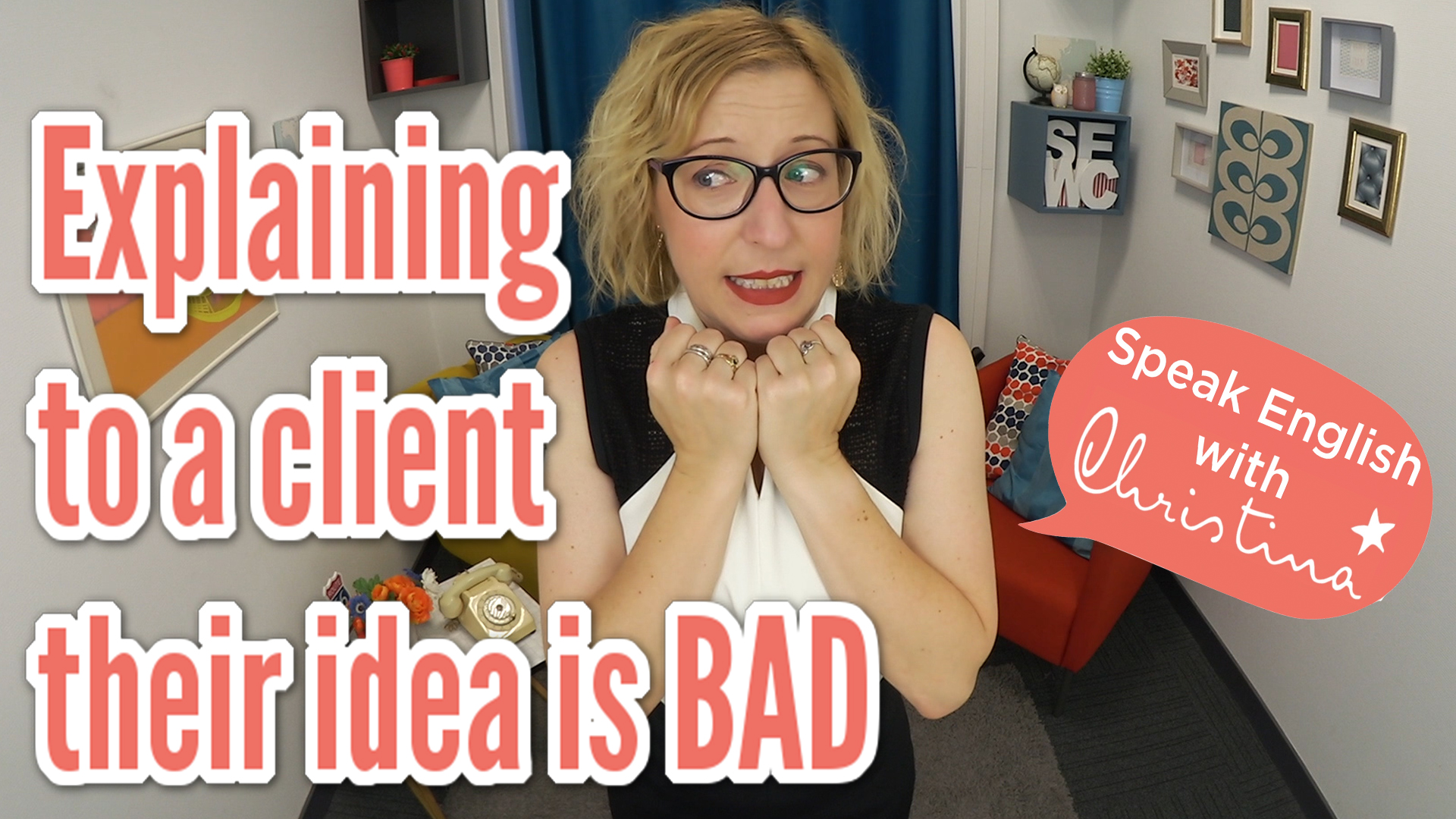
In our professional life, we know it’s important to speak our mind so our clients get the results they want. After all, your clients value your expertise. They pay you for your opinion, right?
But what happens when your client has an idea… that’s quite… well… terrible? Do you give the client your honest opinion?
On the one hand, you want to be a team player. That’s a business idiom that comes from baseball. It means that you want to cooperate and work together.
On the other hand, you understand that your client pays you for your professional insight and experience; they deserve to hear the truth.
In this episode, we’ll explore ways you can let your client know in a diplomatic way that something is a bad idea or won’t work. This way, you can keep your job and not hurt anyone’s feelings.
One of the most effective techniques in diplomatic communication is to use humor and informal language. Sometimes when you’re trying to get a point across, it may come off sounding condescending or snobbish.
Informal language – even American slang – can ease tension in challenging conversations. Telling your client that their idea is bad is just one example of how a deep understanding of real American English can help.
In my Master Real American English program, students unlock the keys in how to speak spontaneously in English and improving pronunciation so you’re understood the first time.
This 3-month virtual immersion is personally tailored to your skill level, and is a terrific way to speak American English without constantly translating in your head, so your conversations are more relaxed and authentic. For more information, go to this page.
The Bad Idea…
You want your client to be happy and you know that they’re paying good money to get results.
Let’s say you manage the marketing efforts for a luxury shoe company. Your client tells you that they have a great new logo and name for their brand. This is their idea…
Your gut tells you this is probably not the right approach to marketing luxury footwear to women. How do you respond?
Never say “You’re Wrong”!
First of all, never say “You’re wrong.” You run the risk of sounding rude and impolite. Plus, if you start with the negatives, or tell your client that they’re wrong, then they will cover their ears and say, “blah blah blah blah.”
In other words, they won’t listen to what you say next.
First, try to find something you like about the idea. Are there any strong points? Identify the positives.
Welcome their Suggestion
Is there something about the idea you like? If so, you can let your client know.
For example, you can say… “For the choice of colors, fluorescent pink is definitely eye-catching…”
Or, “It’s great that you have so many ambitions for this project…”
Or… “About your suggestion to use cat videos in the marketing promotion. It’s true that everyone loves cat videos…”
Or… Well, maybe you can’t really figure out anything positive about your client’s idea. If that’s the case, you start off by expressing how you appreciate their suggestion.
For example, “Wow, I appreciate that you are proactive and take the initiative. ”
Or, “You did a great job putting this together.”
Or, “I appreciate that we can work as a team to find solutions.”
These phrases can make your client feel good about their contributions and your working relationship.
By starting with a positive phrase, you can “soften the blow” when you express your professional opinion about why their idea is bad.
Of course, in order to do this, you want to feel confident and comfortable expressing yourself in English. How? By practicing your conversation skills, so you become fluent and confident.
“In my experience…”
The phrase, “I think…” is not very effective when diplomatically telling your client that their idea isn’t very good. Remember – your client hired you for your professional experience.
This is the perfect opportunity to share with your client reasons why their idea may not achieve the desired results, and show them that you are the expert.
For example, this is a magical phrase, “In my experience….”
“In my experience, the luxury footwear audience appreciates refined craftsmanship. Another client launched their luxury handbag brand using a similar cat video approach, and they did not achieve the desired results. People thought it was cheap.”
This is a great opportunity to mention any high-profile clients you’ve worked with in the past.
“Name-dropping” may remind your client of your credibility and expertise, and why they hired you. For example, “In my experience working with Ralph Lauren…” That sounds like someone worth listening to, right?
Speaking of listening, when dealing with clients, you want to have excellent listening skills! To improve your comprehension and pronunciation in English, I recommend my course Understand Real American English.
“The Current Best Practice…”
Another way to politely tell a client that their idea isn’t very good is to use industry data. This phrase is very good: “The current best practice is…” Again, this shows that you are up to date on what is happening in your field of expertise.
For example: “The current best practice is to convey a sense of timelessness and refined style in luxury footwear. Take a look at the latest industry data that demonstrates how a different approach may help us target more customers…”
Do you see how these two phrases, “In my experience” and “the current best practice” can help you diplomatically explain why an idea isn’t very good?
You aren’t telling your client that YOU disagree or don’t like the idea. You’re telling them why they might not achieve their goals with their idea based on your personal experience or industry data and trends.
Moving Forward with a Bad Idea?
If your client insists on moving forward with their idea and you strongly disagree, you always have a choice. You can continue with their idea and test the results.
Perhaps with more data you can persuade your client that another idea may work better. Of course, it’s possible that their terrible idea will be successful!
And you can always offer to touch base on the results, a few months after their idea has been implemented. This way, you can show that you are involved in their success, and if their idea isn’t successful, you can remind them how you’ll help them succeed… and maybe get another contract!
Or you can politely terminate the relationship. This is best done in writing to formalize the agreement, but of course it’s also fair to give your client a warning in person.
For example, “I want to be honest with you, after considering all of the aspects of this project, I feel like our company is not the best to serve your needs, but I would be happy to refer you to someone better suited for you.”
If your client is professional, you can recommend another expert or company that your client may consider hiring. Doing so is both considerate and good business practice.
And in the end, this allows you to focus your energy on clients you actually work well with.
How about you?
Have you been in a situation where you told a client that their idea wasn’t very good?
If so, share in the comments what words or phrases you used to diplomatically explain why the idea was bad. How did it turn out? I’d like to hear from you!
If you’re a busy professional who needs to level up your fluency, but you find it difficult to go it alone, let me help you, with Master Real American English.
It’s a 3-month virtual immersion coaching program in which my team and I empower you to express yourself fluently and naturally, so that people focus on your professional skills & expertise, not on your level of English.
For more information, go to this page, where you can apply to join this program today.
Thank you for learning with Speak English with Christina, and I’ll see you next time!
More good stuff...
Click the image to learn more








Thank you very much but I need a lot of practice speaking, I have level 3 in ameadest. If you need me, that’s fine and good idea to practice with you and I’m very excited about this opportunity. Thank you.
I came here searching for “How to tell a client their English is bad” 🙂 I don’t mean this rudely at all but actually am just trying to figure out how to suggest to a client, as gently as possible, that some of the phrasing they are asking us to use in marketing is awkward English. Our clients are European and speak great English but the nuances and idioms – especially in marketing and professional language – aren’t really there. Often, they just trust us (my partner and I) and approve our content without hesitation.
But I’ve been finding myself in the position to have to push back sometimes, and I hate it because I feel like I am putting them down. My only other language is high school Spanish of which I remember very little. These folks probably speak three languages or more.
For example, when they’ve asked for a certain awkward or technically incorrect, usually I try to correct it very casually in the process of copywriting and rarely bring it up. When that doesn’t work, I’ve tried, “I get what you are meaning, although to an American ear…” which sounds a little American-depricating, which I think is probably actually a good tone to strike. On the third time, though, I feel like I need to explain the rule of grammar or whatever that applies. That’s where I feel like a jerk. How am I supposed to tell these people that, in professional language, we don’t end a sentence with a preposition. I’m going to say “preposition” to these people?
Ugh. I’m in that situation right this second and have been composing the email, and deleting it, for 30 minutes. 😛 I guess I’m going with “In our experience, this audience may find the language awkward if we end the sentence with ‘for.'” Or else how about, “This is my job and I promise I’m right.” Haha.
Can we just send them this article if they continue to tell you their idea is right and completely within the realm of possibility?
Absolutely!